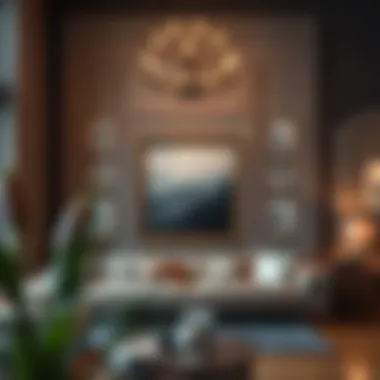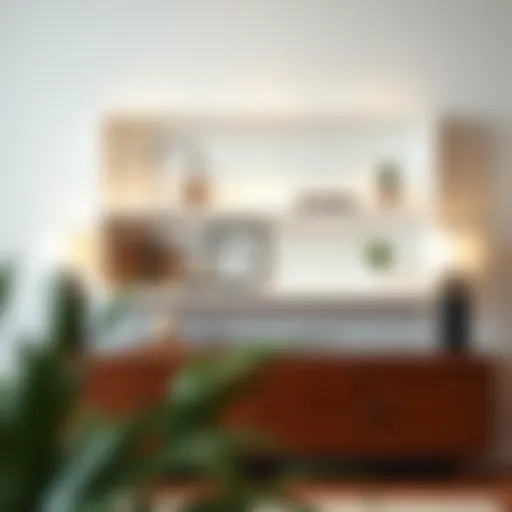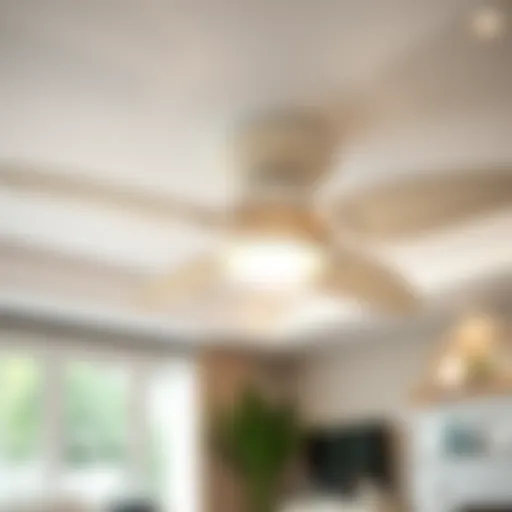Guide to Choosing 8x10 and 11x14 Picture Frames


Intro
When it comes to displaying art or cherished memories, the choice of frame can be as vital as the piece itself. Whether you’re a homeowner looking to enhance your space or a designer aiming for that perfect exhibition, understanding the nuances of frame sizes, particularly 8x10 and 11x14, is essential. This article aims to unpack the details surrounding these popular frame sizes, from their aesthetic characteristics to their practical uses in various settings.
In the world of interior design, frames serve not only as protective barriers for artwork but also as vital components of visual appeal. An artfully selected frame can accentuate the piece it holds, while also contributing to the overall design theme of a room. In many ways, the frames you choose are extensions of your personal taste and the mood you wish to evoke.
Throughout this guide, we will explore the differences between 8x10 and 11x14 frames. You’ll find insights on how these sizes can impact both your artwork’s presentation and the room's aesthetic dynamics. Additionally, we’ll provide practical tips regarding material choices and frame care, enabling you to make informed selections for lasting impact.
Ready yourself as we dive into the heart of framing, where size truly matters.
Foreword to Frame Sizes
When it comes to displaying art or cherished memories, the choice of frame size can be just as significant as the artwork itself. This article dives into the nuances of selecting the right frame, zeroing in on the popular 8x10 and 11x14 sizes. Understanding frame dimensions is more than just numbers on a tape measure; it’s about how frames influence the perception of your photos and artwork, how they enhance or distract from the subject matter, and ultimately, how they contribute to your living space.
Understanding Frame Dimensions
The dimensions of a frame dictate not only the visual weight it bears but also how the contents are showcased within it. Take the 8x10 frame—its snug dimensions often lend themselves to intimate photographs or smaller artwork. Conversely, an 11x14 frame provides a larger canvas, which can make for a striking focal point in any room.
- 8x10 Frame
An 8x10 frame is often favored for individual portraits. It’s the go-to size for family pictures or snapshots of friends that you want to keep close at hand. This size ensures that the details are appreciated without overwhelming the viewer. However, this compact size can sometimes be limiting when it comes to larger art pieces or landscapes. - 11x14 Frame
On the other hand, the 11x14 frame opens up new possibilities. It’s ideal for showcasing intricate pieces of art that require a bit more real estate. The larger size draws the eye and can be effective in making a statement, providing a sense of depth and perspective that smaller frames cannot match. Additionally, this size is often used for prints of high-resolution artwork or photographs, letting fine details shine through.
Importance of Choosing the Right Size
Choosing the right frame size isn’t just about the artwork’s dimensions; it’s an aesthetic decision that can significantly affect your overall decor. The frame acts as a bridge between the art and the environment it occupies.
The right size can:
- Enhance Visual Appeal: A frame too big can overpower the piece, while a frame too small can undercut its impact. Finding that sweet spot ensures that the artwork resonates well within its context.
- Complement Surroundings: The choice of frame size should take into account wall space and other decor elements. A well-placed 8x10 piece can harmonize beautifully with a gallery wall, while an 11x14 can stand out proudly on its own.
- Influence Mood: Different sizes carry distinct emotional weight. For example, an 8x10 framed picture might evoke a feeling of nostalgia and comfort, perfect for family photos. Meanwhile, an 11x14 piece could impart a feeling of elegance and modernity in a more open space.
"The right frame does not merely preserve; it enhances, uplifts, and transforms the art it holds.”
To delve further into the topic, consider checking out Wikipedia on Frame Sizes and exploring retail options at local craft stores or even big-box retailers that offer a variety of choices.
Detailed Look at 8x10 Frames
In the realm of picture framing, the 8x10 size holds a distinct position. This frame size is not just a mere measurement; it offers versatility and utility that stands out in various settings. It bridges the gap between personal keepsakes and professional displays, making it a staple in many households and businesses alike. When we take a closer look at 8x10 frames, it becomes clear that they play a significant role in how we exhibit our most cherished memories and artworks.
Common Uses for 8x10 Frames
The 8x10 frame is a chameleon in the world of interior design. It can fit snugly in multiple environments, whether it be a cozy den, a bright office cubicle, or a chic gallery. Here are some typical applications where 8x10 frames shine:
- Portraits and Family Photos: This size is perfect for traditional portrait photos. It captures expressions beautifully, allowing family memories to take center stage.
- Certificates and Achievements: Academic diplomas or professional certificates deserve to be displayed proudly. The 8x10 frame makes them easily visible and impressive.
- Artwork: Many artists choose 8x10 frames for smaller pieces or prints. It provides a tasteful boundary for their work without overwhelming the artwork.
- Event Flyers or Announcements: Whether you are promoting a birthday party or an art exhibition, an 8x10 frame can help elevate the importance of any event material.
In summary, the common uses of 8x10 frames emphasize their adaptability and suitability for various display needs.
Design Implications of the 8x10 Size
When considering the design implications of the 8x10 frame size, we recognize its proportional balance. This particular dimension does more than just hold a picture; it shapes how viewers interact with the displayed image. Here are key design considerations:
- Proportion and Balance: The 8x10 size allows for a more intimate viewing experience. It encourages viewers to observe details closely, making it ideal for images that tell a story.
- Versatile Styles: This size does not pigeonhole you into one style of decor. Whether you prefer vintage, modern, or minimalist aesthetics, an 8x10 frame can complement various themes.
- Group Displays: When using multiple 8x10 frames, the size facilitates easy arrangements for gallery walls. They can be mixed and matched with other sizes for a dynamic and engaging display.
- Color and Texture Play: The relatively small size encourages experimentation with colors and textures in the frame itself. A bold color or unique texture can act as the perfect contrast to the artwork within.
Exploring 11x14 Frames
In the realm of framing, the 11x14 size often gets overshadowed by its smaller counterpart, the 8x10. However, this frame size deserves its spotlight, as it offers a unique blend of size, versatility, and aesthetic appeal. Selecting the right frame is not just about enclosing a piece of art or a cherished photo; it's about enhancing the visual narrative while ensuring that the artwork complements its surroundings. This section delves into both the typical applications of 11x14 frames and the aesthetic considerations that come into play when opting for this larger format.
Typical Applications for 11x14 Frames
11x14 frames find their way into various settings and usages, making them particularly popular among homeowners and designers alike. Here are some ways you might utilize them:
- Portraits and Personal Photos: This size is often ideal for family portraits, allowing enough space to showcase not only the subjects but also any background elements that add depth to the image.
- Art Prints: Artists often use this size as it bridges the gap between a gallery-style display and casual home decor. When printing larger pieces like illustrations or paintings, 11x14 serves as a suitable canvas to highlight intricate details.
- Certificates and Awards: Many people choose this size when framing important documents, such as diplomas or professional awards, presenting them with an air of significance while keeping them visible without overwhelming a wall.
- Creative Displays: This frame can also be used for collages or collections of smaller images. By grouping prints together, one can create a storytelling piece of wall art that captivates viewers.
Ultimately, the 11x14 frame straddles the line between being big enough to make a statement, yet not so large that it dominates a room. When placed thoughtfully, it becomes a conversation starter, inviting people to reflect on the images framed within.
Aesthetic Considerations for Larger Sizes
Choosing a larger frame like 11x14 means you have to think about how it will interact with both the artwork and the space it occupies. Here are a few factors to keep in mind:
- Proportion and Scale: An oversize frame can dwarf smaller pieces, so consider the scale of both artwork and surrounding decor. A well-sized frame feels balanced within its environment and doesn’t compete with other design elements.
- Visual Anchor: Larger frames can serve as focal points in a room. When selecting an 11x14 frame, think about its role in the overall decor scheme. A bold color or a intricate design can draw attention, while a minimalist approach can harmonize with the aesthetic.
- Clarity and Focus: With a bigger frame comes the possibility of showcasing more detail. Ensure the artwork you choose fits well within the dimensions and stands out without feeling cluttered or lost.
- Matting Choices: Adding a mat can enhance the framed art, creating a barrier that draws the eye to the piece. Matting can also provide contrast, adding depth and richness to the display.
When framing artwork in an 11x14 size, consider how both art and frame work together to define the environment. A well-crafted frame can elevate even simple pieces, turning them into stand-alone attractions.
In summary, 11x14 frames are versatile and impactful choices that cater to a variety of artistic visions and personal expressions. By understanding their applications and aesthetic possibilities, you can make more informed decisions that not only elevate your artwork but also enrich your living spaces.
Comparative Analysis of Frame Sizes


When considering the display of photographs and art, understanding the differences between frame sizes like 8x10 and 11x14 is essential. This section breaks down how each size affects both the visual appeal and the context of your framed pieces. Choosing the right frame isn't just about aesthetics; it directly influences how an image or piece of art is perceived. Proper selection can make your art pop or blend into the background, depending on your desired effect.
Visual Impact of Size Differences
The dimensions of a frame significantly alter how an artwork commands attention. An 8x10 frame, while still offering a presence, carries a more intimate vibe. It's perfect for personal snapshots or smaller art pieces that draw the viewer in upon closer inspection. This size works well on desks, shelves, or small wall spaces where one wouldn't need to step back to appreciate the work, creating a more personal connection.
Contrarily, an 11x14 frame offers a grander visual impact. Larger pieces naturally dominate the space, attracting more attention at a distance. This size is often chosen for gallery displays or living rooms where the aim is to make a statement. Since the frame encapsulates a larger image, the details are magnified, allowing for a bolder presentation that can sometimes command the entire wall.
"The choice between an 8x10 and an 11x14 frame isn’t merely about size; it’s about the story you want to tell through your art."
Additionally, the intended environment plays a role in visual impact. In cozy settings such as home libraries, 8x10 frames can create visual harmony, while 11x14s can act as striking focal points in more open spaces like living rooms or entryways. The interplay of light, space, and color with these sizes can evoke different emotions and reactions, shaping the viewer's experience.
Contextual Suitability
Selecting the right frame size also hinges significantly on the context in which it will be displayed. An 8x10 frame is ideal for bedrooms or hallways, where space is often at a premium and a more subtle touch is desired. Think of it as curating a small collection of cherished moments or memories that invite viewers to take a closer look. These frames are also better suited for mixed displays when combined with other smaller items, creating a gallery-style effect within smaller spaces.
On the other hand, 11x14 frames find their natural home in environments that encourage a more expansive presentation. Installed above a fireplace or as part of a formal gallery wall, this size can elevate the artwork, transforming it from merely decorative to a pronounced centerpiece of the room.
In corporate settings, larger frames are favorable as they convey a sense of professionalism and distinctiveness. An 11x14 piece can make a bold statement in a waiting area, inviting conversation and contemplation, while an 8x10 frame might be relegated to private spaces where personal touches matter most.
In summary, understanding the visual impact and contextual suitability of frame sizes lays the groundwork for effective art display. Whether opting for an 8x10 to foster intimacy or leaning towards an 11x14 for striking visibility, being deliberate in choice will enhance the overall aesthetic and emotional resonance of the displayed work.
Materials Used in Framing
When it comes to framing artwork or photographs, the choice of material plays a crucial role in both the aesthetics and functionality of the display. Understanding the different materials available can empower homeowners and designers to make informed decisions that enhance the overall look and durability of their framed pieces. There are two primary contenders when discussing frame materials: wood and metal. Each material carries distinct qualities and considerations.
Wood vs. Metal Frames
Choosing between wood and metal frames can be likened to picking your favorite tool for a job; each serves its purpose but offers unique advantages.
- Wood Frames: Wooden frames have a timeless quality. They exude warmth and character, suitable for a variety of decor styles. Whether it’s rustic, traditional or contemporary, wood can blend seamlessly. One of the major benefits of wood is its versatility in finishes and textures. Stained, painted, or left natural, wood frames can complement any artwork. The downside, though, is the need for maintenance to prevent warping and damage from environmental factors like humidity.
- Metal Frames: Metal frames, on the other hand, tend to convey a modern and sleek look. They are typically more durable and resistant to the elements, making them a reliable choice, especially for pieces displayed in varying conditions. Metal also tends to be thinner, allowing for a cleaner, minimalist aesthetic. However, the more contemporary feel may not suit all types of artwork, particularly those that draw from rustic or traditional styles.
Let’s not forget that some art enthusiasts prefer to mix and match these materials in their displays, creating a more eclectic look that can add interest to a gallery wall.
Glass vs. Acrylic: Making a Choice
The choice between glass and acrylic as a protective cover for your frames also affects the overall presentation and protection of your pieces.
- Glass: Traditional glass has a classic appeal and offers excellent clarity. It's heavier and provides a more premium feel to frames. However, it's more susceptible to breaking, which is a concern in busy households or public spaces. Also, regular cleaning is required to avoid smudging and streaks, which can detract from the beauty of the art.
- Acrylic: Acrylic is lightweight and shatter-resistant, making it a safer choice for larger pieces or for homes with young children. It can mimic the look of glass quite well, but may scratch more easily and can sometimes create a slight distortion in clarity, depending on quality. More importantly, it tends to be easier to handle and install, saving time and effort.
Both options come with pros and cons, and the choice often boils down to the environment in which the frame will be placed as well as personal preference regarding appearance and practicality.
In forming a complete picture of your framing choices, consider not only the look that you desire but also the longevity and upkeep that comes with each material. It’s all about striking the right balance.
To wrap things up, when selecting materials for framing, think about both aesthetic appeal and practical usability. Sources like Wikipedia and Britannica can provide deeper insights into different styles and materials used in framing, guiding your final choices in an informed manner.
Frame Finishes and Their Effects
When it comes to picture framing, the finish of a frame can drastically alter the perception of the artwork within. Choosing the right finish isn’t just about aesthetics; it influences the overall vibe of your space, how light interacts with your frame, and how well the frame complements the artwork itself. Understanding frame finishes is a key element in achieving a polished display.
Matte and glossy finishes are the primary considerations when selecting frames, each offering distinct advantages that cater to different artistic needs and environment contexts.
Matte Finishes for Subtle Elegance
Matte finishes evoke a sense of understated elegance and sophistication. They diffuse light rather than reflecting it, which allows for a softer presentation. This effect is particularly beneficial for photographs and works on paper where glare might distort the viewer’s experience.
Matte frames can create a tranquil ambiance, making them ideal for spaces designed for relaxation, like reading nooks or bedrooms. They also pair seamlessly with modern artworks that demand attention without overwhelming a room's overall design.
- Benefits of Matte Finishes:
- Reduces glare, enhancing visibility of art
- Provides a timeless and refined look
- Works well in minimalist design schemes
However, while matte finishes offer elegance, they also tend to show fingerprints or dust more prominently. Regular maintenance is necessary to keep them looking pristine. Using a dry microfiber cloth can help maintain their matte appearance without scratching the surface.
Glossy Finishes for Impact
On the flip side, glossy finishes pack a punch when it comes to visual appeal. They shine bright under light, drawing the eye straight to the artwork they hold. This type of finish can enhance vibrant colors and adds a modern touch to the framing. Glossy frames often suit contemporary art and photography where high-impact visuals are required.
The reflective quality of glossy finishes can really make colors pop, giving them a dynamic feel. Consider this finish for:
- Vibrant artwork that needs a contemporary edge
- Bold spaces where you want the frames to stand out
That said, glossy finishes can also lead to unwanted reflections, sometimes hindering the viewer’s ability to appreciate the art fully. Plus, similar to matte finishes, they will need care to avoid scratches and surfaces that appear dull over time.
The choice between matte and glossy frames ultimately comes down to the artwork you’re displaying and the atmosphere you want to cultivate in the space.
In summary, both frame finishes present unique qualities that can enhance or distract from the art they encase. By carefully considering the style, light conditions, and emotional impact of your surroundings, you can select a finish that not only protects but also elevates your artistic presentations.


Whichever finish you select, understanding their effects empowers you to make choices that speak to your design intention and personal taste.
Framing Techniques and Styles
When thinking about frames, one may overlook that framing techniques and styles can greatly impact how artwork or photographs are presented. The choice of framing not only safeguards the art but also enhances its overall appeal, making this a pivotal point of discussion in this guide. Various framing approaches can accentuate the beauty of a piece while harmonizing with the surrounding decor. Whether it’s for personal discretion or a professional display, understanding these techniques allows for better, more intentional choices.
Traditional Framing Methods
Traditional framing methods have stood the test of time, offering a classic approach that many favor even today. These methods often exude a sense of elegance and sophistication, ideal for cherished pieces or formal settings.
Some key aspects of traditional framing include:
- Material Selection: Commonly, wood is the material of choice. Wooden frames come in various stains and finishes, allowing homeowners to achieve a vintage look or a polished appeal.
- Architectural Details: Many traditional frames feature ornate detailing, such as carvings or filigree, which add depth and character. The presence of these elements often makes a simple photo visually richer.
- Mat Board Usage: A mat board serves as a buffer between the artwork and the frame. It creates a visual space that can prevent the art from touching the glass. This not only protects the piece but can enhance its presentation, making the artwork stand out.
For example, an 8x10 family portrait in a dark wooden frame with an off-white mat can look striking in a traditional living room, pulling in warmth and a feeling of nostalgia.
Modern Approaches to Display
As tastes evolve, so do framing techniques. Modern approaches bring a fresh twist, integrating minimalist and innovative styles that tie in with contemporary design trends. These methods often prioritize simplicity and functionality while focusing on the artwork itself.
Key elements of modern framing styles include:
- Sleek Materials: Metal frames and acrylic barriers have gained popularity. They offer a minimalist look that can blend seamlessly into any decor while showcasing the art without distraction.
- Creative Mounting: Instead of traditional mats, techniques like float mounting allow art to appear as if it’s hovering within the frame. This technique not only emphasizes the artwork but also provides a three-dimensional aspect to the display.
- Gallery Walls: Nowadays, many homeowners opt for gallery walls as a way to showcase an assortment of frames and art. Mixing various frame sizes—like 8x10 and 11x14—creates a dynamic visual narrative that speaks to the owner’s personality.
In essence, both traditional and modern framing techniques serve distinct purposes, addressing individual tastes and environmental demands. They take into account everything from the intended atmosphere to the framing material.
"The way we frame art speaks volumes about not only the piece itself but the environment it inhabits; choose wisely to reflect your style."
Frames can transform a simple photograph or artwork into a stunning focal point. Being mindful of framing techniques and styles not only assures the safety of the pieces but enhances one’s living or working spaces.
Customization Options for Frames
When it comes to choosing picture frames, customization offers a way to make the frame reflect personal taste and the spirit of the artwork it holds. The power of customization lies not just in the aesthetic appeal, but also in ensuring that the frame complements the setting in which it will be displayed. With 8x10 and 11x14 sizes being quite popular, understanding how to tailor these frames to meet specific needs becomes essential especially for homeowners, designers, and art enthusiasts.
Customization can include selecting materials, colors, finishes, and even frame styles. The emphasis on customization elevates an ordinary frame to a centerpiece, allowing the artwork or photograph to shine. Here are several important aspects the article will cover:
- The benefits of customization include enhancing visual appeal and ensuring harmony with home decor.
- Specific considerations when customizing frames, such as matching colors or choosing materials suited for the artwork's environment.
Personalization also adds a level of uniqueness, making the display more engaging. Hence, it's worth taking a gander at how these options can be optimized to create something truly special.
Personalizing Your Frame Choice
Personalizing an 8x10 or 11x14 frame can significantly impact your space. Think of it as dressing up your artwork, like choosing the right outfit for an occasion. With a range of materials and finishes available, it’s essential to ask yourself what character or emotion you want your frame to convey.
When selecting colors, consider the existing palette in the room. If your walls are painted in muted tones, a vibrant color might add a nice pop. Conversely, a subdued frame might suit a more colorful artwork.
Additionally, the choice of material plays a role in conveying the right message. A sleek metal frame could impart a modern touch, while a rustic wooden frame may resonate with a more traditional decor. Here are a few tips for personalizing your frame choice:
- Consider the existing decor—Does it clash or harmonize?
- Select colors that resonate with the artwork or accentuate its features.
- Material choice—Wood, metal, or something else? What story does that tell?
Incorporating Unique Designs
Incorporating unique designs into your frames, particularly with the 8x10 and 11x14 dimensions, gives an opportunity to showcase creativity. It can transform a simple frame into a conversation starter. You might consider unique style choices, such as:
- Custom engravings: Your name, a date, or even a meaningful quotation can add a distinct touch.
- Mixed materials: Combining wood and metal or glass introduces an interesting visual element.
- Artistic embellishments: Ribbons, floral accents, or even decorative motifs can make frames stand out even more.
By adding these elements, you ensure that your frames not only serve their primary function but also tell stories and create depth in your decor. Every piece can echo your personality or the uniqueness of the artwork it's housing.
In summary, customization options play a vital role in selecting picture frames, particularly in how they can elevate the art they encase. By personalizing frame choices and incorporating distinct designs, you foster an environment that speaks to you and those who appreciate your space.
Maintenance and Care for Frames
Taking care of your picture frames is just as crucial as selecting the ideal ones for your home or gallery. Maintenance and care for frames not only ensures their longevity but also preserves the integrity of the photographs or artwork they contain. Proper upkeep can prevent damage from environmental factors like dust, humidity, and light exposure. Let’s delve deeper into effective strategies to keep your frames looking pristine, making sure they remain a beautiful part of your decor for years to come.
Cleaning Techniques for Longevity
Regular cleaning is vital for maintaining the beauty of your frames. Dust and dirt can accumulate over time, dulling their appearance and potentially harming the materials used. Here are some effective cleaning techniques to consider:
- Use a Soft Cloth:
- Dust Regularly:
- Spot Cleaning:
- Glass Care:
- Avoid Direct Sunlight:
- Always choose a soft, lint-free cloth for cleaning. Microfiber is ideal because it's gentle and won’t scratch the surface.
- A quick dusting every few weeks can be enough to prevent buildup. It’s best to do this with a dry cloth or a duster.
- For more persistent stains or spots, slightly dampen the cloth with water or a mild cleaning solution. Be sure to avoid any harsh chemicals that could strip the finish or damage the frame.
- If your frame includes glass, use a glass cleaner and a microfiber cloth to avoid streaks. Cleaning in circular motions often yields the best results.


- Keep frames out of direct sunlight. Sunlight can fade photographs and art over time, making them look worn.
"A regular cleaning routine is the best way to extend the life of your frames and the art within."
Environmental Considerations
Frames are often exposed to a variety of environmental factors that can impact their longevity. Being aware of these considerations helps in selecting the right location and materials for your framed pieces.
- Humidity Levels:
High humidity can lead to mold and mildew, especially in wooden frames. If your home is humid, consider using dehumidifiers. - Temperature Fluctuations:
Extreme temperature changes can cause materials to expand and contract, possibly leading to warping or cracking over time. - Air Quality:
If possible, keep frames away from areas with heavy pollution or smoke. These substances can create tiny films on surfaces that require more intensive cleaning. - Choice of Materials:
Select frames made from high-quality materials that suit your local environment. For instance, metal frames might be more suitable in humid areas than wood, which is prone to swelling.
Being mindful of these environmental factors plays a significant role in the upkeep of your frames.
Practical Applications in Home Decor
When it comes to designing interior spaces, the importance of choosing the right frames cannot be overstated. Frames are more than just protective enclosures for photographs or art; they are essential tools for enhancing aesthetic appeal and creating cohesion in any room. This section dives into the numerous practical applications of 8x10 and 11x14 frames in home decor, highlighting their versatility and the transformative effects they offer.
Consider that a well-placed frame can instantly elevate the ambience of a room. Whether it's a cozy den or a formal living room, the selection of frame size, style, and arrangement plays a significant role in delivering a polished look. Specifically, 8x10 and 11x14 frames are popular choices due to their manageable dimensions and adaptability, allowing homeowners to tailor their decor to reflect personal tastes.
Gallery Walls and Frame Groupings
Creating a gallery wall can be a showstopper in home decor. A gallery wall consisting of various frame sizes, including 8x10 and 11x14, allows homeowners to display an eclectic mix of art, photographs, and personal mementos. Here are a few points to keep in mind:
- Mix and Match: 8x10 frames often work well as smaller accents in a gallery wall, while 11x14 frames can serve as focal points. This variety can create a visual rhythm and prevent monotony.
- Layout Considerations: Before hammering nails into the wall, consider plotting your design on the floor first. Arrange 8x10s and 11x14s together to see how they interact, creating a balanced layout that draws the eye without overwhelming.
- Theme Consistency: Use framing styles that echo a common theme—whether it's rustic wood frames paired with vibrant artworks or sleek metal frames with black-and-white photography. The right combination will harmonize the gallery wall.
"An inviting gallery wall brings depth and character to any space, be it an understated entryway or a lively family room."
Standalone Usage in Various Spaces
In addition to gallery walls, 8x10 and 11x14 frames serve beautifully as standalone pieces in any given room. Here’s how:
- Nooks and Corners: A well-placed frame on a side table or shelf can add a touch of personality. Imagine a treasured photograph in an 8x10 frame nestled next to a plant on a coffee table.
- Focal Points: Larger 11x14 frames can make a striking statement when used alone. A piece of contemporary art or an abstract photograph can serve as a conversation starter, drawing visitors’ attention without competing with other room elements.
- Functional Displays: Consider using these frames to showcase daily reminders, inspiring quotes, or even seasonal decor. An 11x14 frame displaying a family calendar or a holiday greeting can provide both functionality and visual interest.
Utilizing both 8x10 and 11x14 frames encourages creativity and individual expression within the home. Homeowners and designers alike can benefit from these versatile framing options, whether highlighting personal experiences or enhancing an overall decor strategy. Optimizing frame usage in practical applications like gallery walls or standalone displays leads to cohesive and inviting environments.
Framing for Artwork vs. Photography
When it comes to decorating a space with personal flair, the choice between framing artwork and photography holds significant weight. Selecting the correct frame can enhance your visuals and even affect the mood within a room. Both mediums require careful consideration for framing, each bringing unique challenges and benefits that influence not just aesthetic quality but also preservation and presentation.
Choosing Frames Based on Art Medium
Picking a frame isn't just about going with what looks good; it hinges on the medium of the art itself. Different materials and styles resonate with various forms of artwork. For instance, an oil painting often benefits from ornate wooden frames that provide depth and character, while a contemporary abstract piece might shine in a sleek, minimalist metal frame. The choice between 8x10 and 11x14 frames also comes into play, as larger pieces can draw attention with more elaborate framing, while smaller artworks might get overwhelmed by a bulky frame.
Key considerations when choosing frames based on the art medium:
- Material Compatibility: Different materials can affect how the artwork is viewed.
- Color Coordination: The frame color should complement the piece. Warm wooden tones enhance rustic art, while cool metals suit photographs with modern themes.
- Size Matters: For art mediums requiring more focus, a larger frame can provide a dramatic effect. Conversely, an 8x10 frame might draw the eye effectively to smaller canvas works or photos where intimate details matter.
- Paintings might require deeper frames to accommodate thickness.
- Prints, especially photographic ones, often look great in a floating mount, highlighting their borders and preventing dust accumulation.
The Role of Framing in Photography Presentation
Photography, being a more direct representation of reality, demands a different approach to framing compared to traditional artwork. The role of a frame in photography presentation is to enhance the visual story without overshadowing the image itself.
Essential aspects of framing for photography include:
- Protection from Damage: Photographs can be susceptible to fading and wear. A good frame with UV-protective glass can extend the life of the photo, keeping colors vibrant.
- Highlighting the Subject: The frame should accentuate the photograph, drawing eyes without being distracting. A simple black frame might work wonders for a striking portrait, whereas vibrant colors could suit travel photos, making them pop on the wall.
- Creating a Cohesive Look: When presenting a collection of photographs, such as in a gallery wall setting, consistent framing styles can tie the pieces together visually, providing a sense of harmony and cohesion throughout the display.
"Selecting the right frame is not only about aesthetics; it is crucial for preserving your cherished memories and enhancing your living spaces."
Ultimately, whether you're framing a delicate painting or a cherished family photo, understanding the differences in framing requirements is integral to maximizing the impact of your artwork. A well-chosen frame serves as a boundary that not only protects but enhances the beauty and intention of the piece within.
Ending: Making Informed Choices
As we wrap up this in-depth exploration of 8x10 and 11x14 frames, it becomes clear that making informed choices is paramount for anyone looking to enhance their space or preserve precious memories. The frame you choose does more than merely encase art or photographs; it contributes to the overall aesthetic and emotional resonance of your environment. Understanding what each size and style brings to the table allows you to curate your display in a way that resonates with your personal taste and complements your interior decor.
Recapping Frame Selection Essentials
In selecting frames, several factors come into play that are worth emphasizing:
- Size Considerations: Choosing between 8x10 and 11x14 depends on the visual impact you'd like to create. An 8x10 frame is perfect for smaller, more personal artworks or family photos, while an 11x14 frame makes a bolder statement, suitable for larger pieces or gallery-style displays.
- Material Selection: Different materials influence both the look and durability of your frames. Wood frames evoke warmth and tradition, whereas metal frames often signify a more modern aesthetic. Both materials offer varying finishes that can enhance or detract from the artwork within.
- Design and Style: Your frame should align not only with the artwork but also with the surrounding decor. Classic, ornate frames may suit a vintage style, while sleek, minimalist frames might better fit contemporary settings.
- Maintenance and Care: Proper care extends the life of your frames and the artwork they protect. Regular cleaning with suitable materials ensures that dust and grime don’t accumulate, dulling the frame’s appeal over time.
Future Trends in Framing
As we move forward, several trends stand out in the world of framing. One noteworthy direction is the increased demand for sustainable materials. Consumers are becoming more aware of the environmental impact of their purchases, leading to a surge in options made from recycled or responsibly sourced materials.
Furthermore, customization is on the rise, with personalized frames becoming popular. Homeowners and designers are seeking unique solutions that reflect individual style rather than opting for mass-produced items. The advent of technology has made customization easier, with online platforms offering frame design tools that put creativity in the hands of the buyer.
In the artistic realm, we can expect an integration of digital art into traditional framing methods. Digital prints will necessitate different considerations when selecting frames, particularly in terms of protection against UV damage.
As we conclude, it's evident that understanding the nuances of frame selection not only gives you the confidence to choose wisely but also allows you to express your personality and style through your decor choices. By taking the time to consider the essentials discussed in this article, you are better equipped to make decisions that enrich your living spaces.















